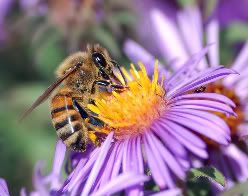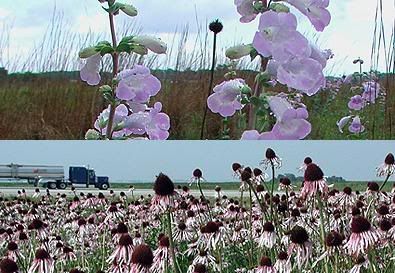Could bioenergy save the bees?
 Over the past few months, stories about the dramatic die-off of bee colonies have grabbed headlines. In the U.S., the situation is critical, with the phenomenon - dubbed "colony collapse disorder" (CCD) - eliminating anywhere between 30 and 70 percent of all bee-hives. The situation is not much better in Europe. According to many scientists, the collapse of bee colonies is due to a complex cocktail of factors: the use of pesticides and insecticides, the emergence of a destructive mite which helps spread a deadly virus, a changing climate, the reliance on monocultures and a general lack of biodiversity. Tackling this crisis is crucial, because bees pollinate a whole range of crops - from oranges to soy beans - which provide 30% of all our food.
Over the past few months, stories about the dramatic die-off of bee colonies have grabbed headlines. In the U.S., the situation is critical, with the phenomenon - dubbed "colony collapse disorder" (CCD) - eliminating anywhere between 30 and 70 percent of all bee-hives. The situation is not much better in Europe. According to many scientists, the collapse of bee colonies is due to a complex cocktail of factors: the use of pesticides and insecticides, the emergence of a destructive mite which helps spread a deadly virus, a changing climate, the reliance on monocultures and a general lack of biodiversity. Tackling this crisis is crucial, because bees pollinate a whole range of crops - from oranges to soy beans - which provide 30% of all our food.Perhaps the key to solving the problem can be found in growing energy crops. Here is how and why.

Polycultures of native prairie grasses and flowers in the U.S., studied for their use in bioenergy systems. Credit: Tallgrass Prairie Center.
- Energy crops for use in the production of power and heat must achieve only one main goal: yielding a large amount of lignocellulosic biomass. It doesn't matter whether the crop yields sugar or oil-seeds, grows tall or dense; it must yield biomass, preferrably low in ash content. That's it. Other requirements, like the establishment and harvesting costs play a role, but are of secondary importance.
- This very limited requirement - the aim to obtain high biomass yields - allows for the selection of crops from a very diverse list of candidates. Energy crops can be combined in smart systems, and restore biodiverse-rich ecosystems. A well-studied and key example concerns so-called "low-input high-diversity systems", which yield more biomass than monocultures, and which offer important ecosystem services, such as the sequestration of carbon in soils. Moreover, such biodiverse polycultures require almost no artificial inputs like fertilizers, pesticides or insecticides (earlier post).
- On this basis, scientists can begin to design biodiverse energy crop systems which contain a variety of native flowering crops, rich in nectar, which would form a haven for pollinators like bees. These systems would be optimized for biomass production, and, besides sequestering carbon in soils, would re-establish the key ecosystem service of providing "health recovery zones" for pollinators, which guarantee the resilience of our food production system.
- Such bee-and-biomass centered crop systems would eliminate all the factors suspected of contributing to CCD: they would reduce the need for pesticides and insecticides, they would counter-balance monoculture-based farming, they would contribute to tackling climate change, and they would restore biodiversity.
- It would be interesting to analyse the feasibility of this broad concept. Farmers could be stimulated to establish such biodiverse "biomass corridors" throughout the agricultural landscape. Depending on the system, different incentives could make these corridors commercially viable: (1) the carbon market could provide credits for the sequestration of carbon in soils; (2) the same market could offer utilities and energy producers incentives to use biomass in power plants; (3) farmers could be paid for re-establishing the conditions needed to maintain healthy pollinator populations, which offer ecosystem services of an immense value (according to the USDA, bees alone contribute around $15 billion a year to American agriculture).
However, the emergence of a competitive biomass sector could well be exactly what we need to restore the landscape in favor of pollinators. This sector potentially has the scale to transform agriculture away from monocultures to polycultures, as well as the necessary commercial strengths, because biomass is the most competitive of the renewable energy options. Incentivising farmers via ecosystem-service credits, would make the proposition feasible.
In conclusion, smart energy crop systems could offer the key to solving the bee-crisis, which threatens our entire food system. It will be a matter of designing intelligent cultural complexes based on a biodiverse mix of native crops, selected for yielding high amounts of biomass and including a range of flowering plants that attract pollinators.
Entry ends here - Biopact Team, 2008, CC.
 energy :: sustainability :: biomass :: bioenergy :: biodiversity :: polycultures :: pollination :: bees :: colony collapse disorder ::
energy :: sustainability :: biomass :: bioenergy :: biodiversity :: polycultures :: pollination :: bees :: colony collapse disorder ::  --------------
--------------
 Mongabay, a leading resource for news and perspectives on environmental and conservation issues related to the tropics, has launched Tropical Conservation Science - a new, open access academic e-journal. It will cover a wide variety of scientific and social studies on tropical ecosystems, their biodiversity and the threats posed to them.
Mongabay, a leading resource for news and perspectives on environmental and conservation issues related to the tropics, has launched Tropical Conservation Science - a new, open access academic e-journal. It will cover a wide variety of scientific and social studies on tropical ecosystems, their biodiversity and the threats posed to them.









0 Comments:
Post a Comment
Links to this post:
Create a Link
<< Home